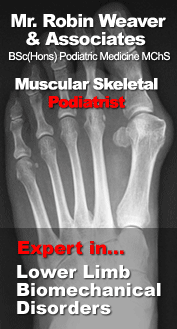 Morton's Neuroma
Morton's Neuroma
Symptoms
- Pain most commonly in the ball of the foot and affecting
one or two of the lesser toes (usually the third and fourth)
- Pain can sometimes radiate to the top of the foot
- The pain may can be intermittent in nature - it may disappear as quickly
as it came
- Pain is often sharp, burning, or cramping in nature
- Pain may radiate into the tips of the toes or up the foot/
leg
- Aggravated by tight shoes and prolonged weight-bearing
- Removing the shoe often relieved the pain
Causes
- May involve mechanical irritation of the nerve
- Abnormal foot structure or mechanics (for example. flatfeet or
excess foot pronation) contributes to irritation of the nerve
- Tight fitting footwear may contribute to the problem
What you can do
- Remove the shoe and massage your forefoot
- Rest the foot
- Wear shoes with a broad forefoot, low heel, and a good
arch (e.g.. running or walking shoe)
- Use a prefabricated pronation control orthotic such as the Orthosport Activ-8 ™ orthotic, a perfect choice for moderate over pronators
What might a Podiatrist do?
- Order special diagnostic imaging to establish a diagnosis
- Identify why the Neuroma developed
- Physically manipulate the foot attempting to feel (palpate) the enlarged
nerve
- Gently mobilise a joint to restore normal movement,
applicable when restricted joint movement is causing nerve
sheath irritation.
- If abnormal foot motion is causing
compression/irritation of the nerve sheath your Podiatrist
may prescribe Casted
Orthotics to control abnormal foot motion
- Apply orthopaedic pads to relieve pressure on the nerve
- Use physical therapy ie ultrasound
- Inject powerful anti-inflammatory medication around the
affected nerve
- Cryosurgery. See our Cryosurgery for Morton's Neuroma page for details...
- Recommend surgical excision of the affected nerve generally
a last resort (due to potential complications such as scar
tissue, loss of normal sensation and recurrence). See below.
Conventional Neuroma Surgery
Conventional surgery involves a general anaesthetic or local anaesthetic foot block, followed by excision of the neuroma. The surgery generally requires the use of: stitches, strong pain killers and a post operative shoe or boot that is worn for several weeks. The stitches should be kept clean and dry.
Complications of conventional surgery include: post-operative infection, haematoma, numbness and the development of a stump neuroma. Stump neuroma (stump neuroma are neuroma that form at the stump of the excised nerve). Stump neuroma are frequently as painful as the original neuroma and sometimes more so. Stump neuroma formation occurs in approximately 20% of patients that undergo conventional surgery.
Other causes of forefoot pain
- Metatarsalgia (pain and inflammation of the metatarsal
bones and their soft tissue sheath)
- Capsulitis (pain and inflammation of the joints between
the metatarsal bones and toes)
- Tendonitis (inflammation of the tendons which run along
the top of the foot)
- Dislocation of a joint between a metatarsal and a toe
(metatarsal-phalangeal joint)
- Severe plantar callus (callus on bottom of the foot) or
bursitis (an inflamed fluid-filled sack often between a bone
and an area of pressure)
|
...............................
 top
of page
top
of page
 ............................
............................ |

